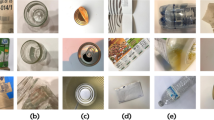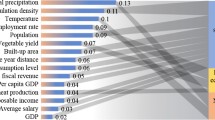Abstract
This paper addresses the problem of predicting multiple factors of health care waste recycling for promoting the construction of ecological civilization against the background of a comprehensive implementation of the “healthy China” strategy. In this paper, an improved gray neural network model is developed for recovery prediction. The one order single variable gray model and triple exponential smoothing are used for predicting the factors affecting recovery. A particle swarm optimization optimized back propagation (BP) neural network is trained by selecting higher-prediction results by precision comparison, and the trained BP neural network is used to predict the recovery of health care waste. Taking Shanghai as an example, this paper uses the actual data about Shanghai health care waste during 2013–2017, and the historical data of 11 factors affecting the recovery amount; these are used for empirical analysis. The results of this research show that the gray neural network performs better than other benchmark models and traditional predictive models. An accurate prediction of the amount of health care waste recovered can help decision-makers to implement recycling, and can serve as a reference for governmental departments, helping them to formulate relevant laws and regulations, develop a variety of tasks, and rationally allocate resources.











Similar content being viewed by others
References
Adamović VM, Antanasijević DZ, Ristić M, Perić-Grujić AA, Pocajt VV (2018) An optimized artificial neural network model for the prediction of rate of hazardous chemical and healthcare waste generation at the national level. J Mater Cycles Waste Manag 20(3):1–15
Bahrami S, Hooshmand RA, Parastegari M (2014) Short term electric load forecasting by wavelet transform and grey model improved by pso (particle swarm optimization) algorithm. Energy 72(7):434–442
Bai Y, Xiao H, Tong C, Hua Y (2015) Quadratic kernel-free least squares support vector machine for target diseases classification. J Comb Optim 30(4):850–870
Bing W, Han X, Zhang X, Zhang S (2015) Predictive-reactive scheduling for single surgical suite subject to random emergency surgery. J Comb Optim 30(4):949–966
Cheng H, Yang W, Tong C (2017) Prognostics and health management of life-supporting medical instruments. J Comb Optim 1:1–13
Luo D, Liu SF, Dang YG (2003) The optimization of grey model GM (1,1). Eng Sci 5(8):50–53
Deng J (1987) Gray system basic method. Huazhong University of Science and Technology Press, Wuhan
Fan HM, Qi TX, Mu XW (2013) Forecasting of medical waste generation amount based on gm (1, n) model. Adv Mater Res 726–731:2850–2854
Feng Y, Kitzmiller DH (2006) A short-range quantitative precipitation forecast algorithm using back-propagation neural network approach. Adv Atmos Sci 23(3):405–414
Guo ZH, Wu J, Lu HY, Wang JZ (2011) A case study on a hybrid wind speed forecasting method using bp neural network. Knowl Based Syst 24(7):1048–1056
Hao H, Wang Z, Lin H, Zhang Q, Huang M, Zhu J (2017) Fifth profit source: commercial value and mode of reverse logistics in China. Logist Technol 36(8):47–50
Hao H, Zhang Q, Wang Z (2018a) Feasibility evaluation for reverse logistics of end-of-life vehicles battery based on improved fuzzy neural network. China Busi Market 32(6):15–24. https://doi.org/10.14089/j.cnki.cn11-3664/f.2018.06.002
Hao H, Zhang Q, Wang Z, Zhang J (2018b) Forecasting the number of end-of-life vehicles using a hybrid model based on grey model and artificial neural network. J Clean Prod 202:684–696
Hu B, Fang P, Lei W (2017) A scheduling algorithm for medical emergency rescue aircraft trajectory based on hybrid estimation and intent inference. J Comb Optim 4:1–22
Jiang SJ, Jiang CG (2008) Urban water demand forecasting by combining improved BP neural network and grey model with optimum weight. J Chongqing Jianzhu Univ 30(2):113–115
Liu S (2005) Prediction technology and method. Higher Education Press, Beijing
Niu W, Cheng J, Wang G (2013) Applications of extension grey prediction model for power system forecasting. J Comb Optim 26(3):555–567
Wang Z, Hao H, Gao F, Zhang Q, Zhang J, Zhou Y (2019) Multi-attribute decision making on reverse logistics based on dea-topsis: a study of the Shanghai end-of-life vehicles industry. J Clean Prod 214:730–737
Wu D, Gao H (2016) A BP and switching PSO based optimization approach for engine optimization. Natl Acad Sci Lett 40(1):1–5
Yu X, Jin H, Shi L, Ying W, Zhao Y (2017) Application of a BP neural network in predicting destroyed floor depth caused by underground pressure. Environ Earth Sci 76(15):535
Zhang E, Hou L, Shen C, Shi Y, Zhang Y (2016) Sound quality prediction of vehicle interior noise and mathematical modeling using a back propagation neural network (BPNN) based on particle swarm optimization (PSO). Meas Sci Technol 27(1):015801
Zhao R, Liu D, Li Q, Liu J (2008) Medical waste production forecasting research. J Chengdu Med Coll 3(2):115–119
Acknowledgements
The authors would like to thank the editor for the constructive comments on improving an early version of this paper. This research was supported by Research Center of Resource Recycling Science and Engineering, Shanghai Polytechnic University and Gaoyuan Discipline of Shanghai-Environmental Science and Engineering (Resource Recycling Science and Engineering) (A30DB182602); Shanghai Polytechnic University Management Science and Engineering Discipline Construction Fund (XXKPY1606); Key Project of Shanghai Soft Science Research Program (19692107700).
Author information
Authors and Affiliations
Corresponding author
Additional information
Publisher's Note
Springer Nature remains neutral with regard to jurisdictional claims in published maps and institutional affiliations.
Rights and permissions
About this article
Cite this article
Hao, H., Zhang, J., Zhang, Q. et al. Improved gray neural network model for healthcare waste recycling forecasting. J Comb Optim 42, 813–830 (2021). https://doi.org/10.1007/s10878-019-00482-2
Published:
Issue Date:
DOI: https://doi.org/10.1007/s10878-019-00482-2




